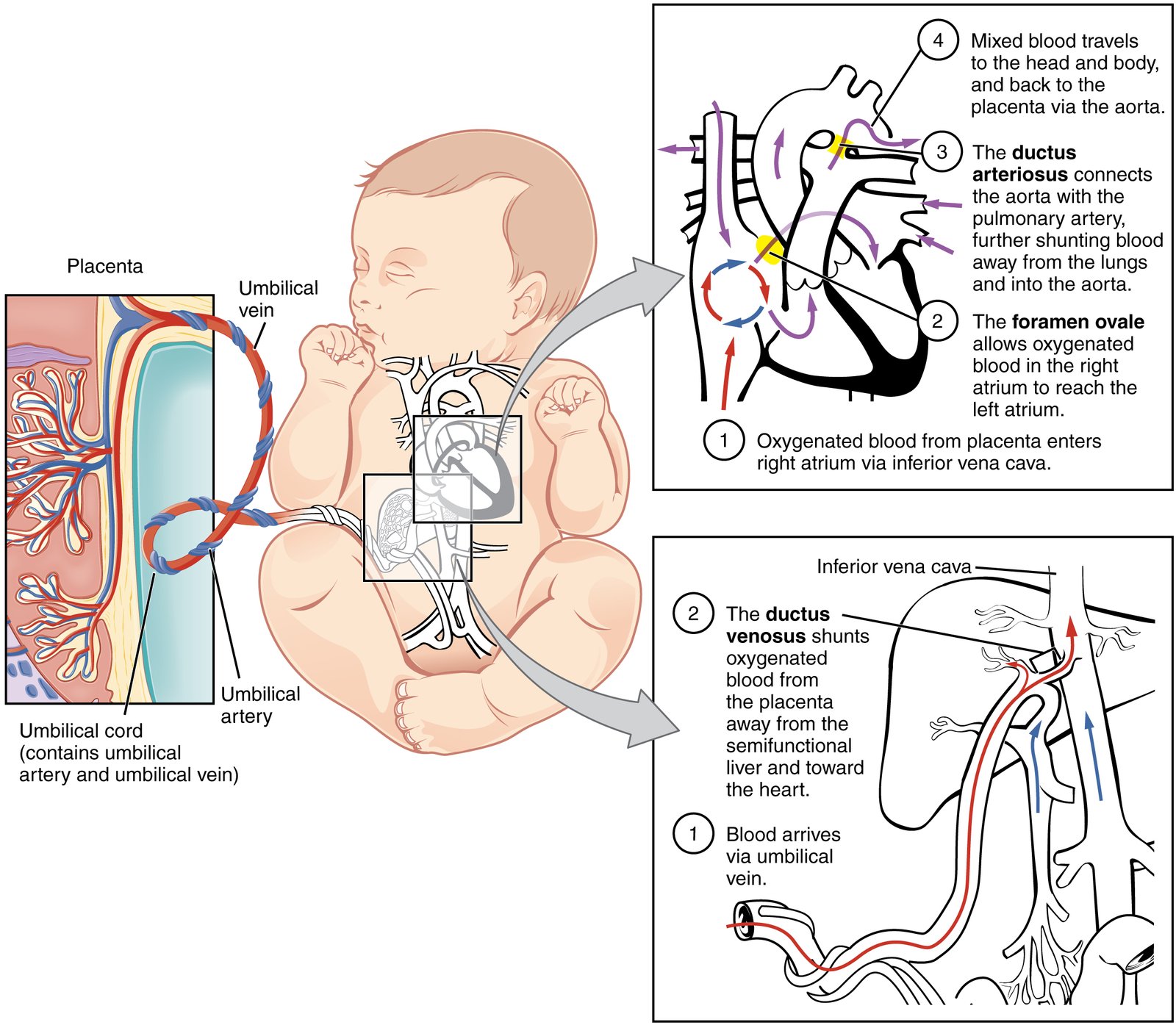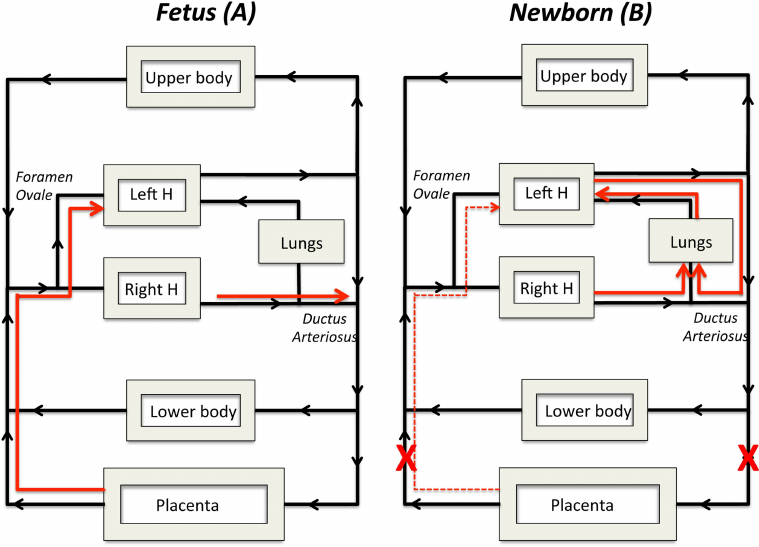Fetal circulatory system-The course is designed for the basic understanding of anatomical structures and physiological functions of human body, musculoskeletal system, digestive system, respiratory system; cardiovascular system; urinary system, endocrine system, reproductive system, nervous system, hematologic system, sensory organs, integumentary system, and immune system.The aim of the course is to acquire knowledge and skills regarding anatomy and physiology.
Fetal circulatory system

Fetal Circulatory System
Introduction
- The fetus is connected by the umbilical cord to the placenta, the organ that develops and implants in the mother’s uterus during pregnancy
- Through the blood vessels in the umbilical cord, the fetus receives all the necessary nutrition. oxygen, and life support from the mother through the placenta
- Waste products and carbon dioxide from the fetus are sent back through the umbilical cord and placenta to the mother’s circulation to be eliminated
Inside the fetal Circulatory:
- Blood from the placenta flows through the umbilical vein to the umbilicus Divides into two branches. One to the liver and the second and larger, ductus venosus, empties directly into the fetal vena cava
- The blood enters the right atrium, passes through the foramen ovale into the left atrium. Flowing into the left ventricle which pumps it into the aorta.
- A small amount of blood from the upper extremities and head flows into the right atrium through the tricuspid valve into the right ventricle which then is pumped into the pulmonary artery and a small portion to the lungs.
- The larger amount of blood from the pulmonary artery flows into the descending aorta through the ductus arteriosis
- Blood returns to the placenta through the umbilical arteries.

Pathway of Blood in Fetus
High Oxygenated blood from mother flows through umbilical vein to fetal heart some perfuses liver
most goes to inferior vena cava via ductus venosus and then to R. Atnum Blood can take two paths, ultimately to bypass non-functional fetal lungs
1) Right atrium foramen ovale Left atnum Left ventricle aortasystemic circulation umbilicalarteries placenta
2) Right atrium Right ventricle pulmonary trunk ductus arteriosus aorta umbilicalarteries placenta
foramen ovale and ductus arteriosus are special structures that allow for specific fetal blood flow:
At birth
At birth, the umbilical cord is clamped and the baby no longer receives oxygen and nutrients from the mother With the first breaths of life, the lungs begin to expand. As the lungs expand, the alveoli in the lungs are cleared of fluid An increase in the baby’s blood pressure and a significant reduction in the pulmonary pressures reduces the need for the ductus arteriosus to shunt blood. These changes promote the closure of the shunt. These changes
increase the pressure in the left atrium of the heart, which decrease the pressure in the right atrium. The shift in pressure stimulates the foramen ovale to close.
The closure of the ductus arteriosus and foramen ovale completes the transition of fetal circulation to newborn circulation.
Adult Forms of Fetal Vascular Structures
Ductus arteriosus: Within 1-2 days of birth, the ductus arteriosus constricts so that no more blood can flow through it. Within a few weeks, new connective tissue replaces the ductus arteriosus and it becomes known as the ligamentum arteriosum.
Foramen ovale: The foramen ovale closes when pressure in the left atrium increases to exceed the pressure in the right atrium. The pressure change forces the foramen ovale against the atrial septum, preventing blood from passing into the left atrium from the right ventricle and separating the heart into right and left halves. The remnant of the foramen ovale is known as the fossa ovalis
Ductus venosus: The ductus venosus constricts and closes soon after birth. It becomes the ligamentum venosum, a cord of connective tissue that attaches to the liver.
Umbilical cord: Once the doctor cuts the umbilical cord, the umbilical vein and arteries constrict to prevent blood loss. The cut umbilical cord becomes the belly button. For the first three weeks or so, the newborn baby has an umbilical stump, which should be allowed to dry and fall off on its own. Some doctors recommend cleaning the umbilical stump with rubbing alcohol to prevent infection
After the umbilical cord is cut, the blood in the umbilical vein and arteries clots, closing off the blood vessels. The remnant of the umbilical vein is the ligamentum teres hepatis, which develops within months of the baby’s birth. The umbilical arteries become the medial umbilical ligaments

References of Human Fetal blood Circulation
- Whitaker, Kent (2001) “Eetal Circulation Comprehensive Perinatal and Fediatric Respiratory Care. Delmar Thomson Learning pp. 18-20. ISBN 978-0-7668-1373-1
- Kisenud Toonid Acharya, Ganesh (2004). “The fetal circulation” Prenatal Diagnosis 24 (13) 1049-39
- Так поw wеll pregnancy book by Mike Samuels, M.D., and Nancy Samuris, New York Fireside. Simon and Schuster Inc. 1996
Measurement techniques for cardiovascular
- ECG/EKG/Electrocardiogram for cardiac electrophysiology
- Sphygmomanometer and stethoscope for blood pressure
- Pulse meter for cardiac function (heart rate, rhythm, dropped beats)
- Pulse commonly used to determine the heart rate in absence of certain cardiac pathologies
- Heart rate variability used to measure variations of time intervals between heart beats
- Nailbed blanching test test for perfusion
- Vesselcannula or catheter pressure measurement-pulmonary wedge pressure or in older animal experiments
Read more:
